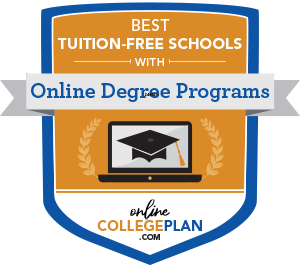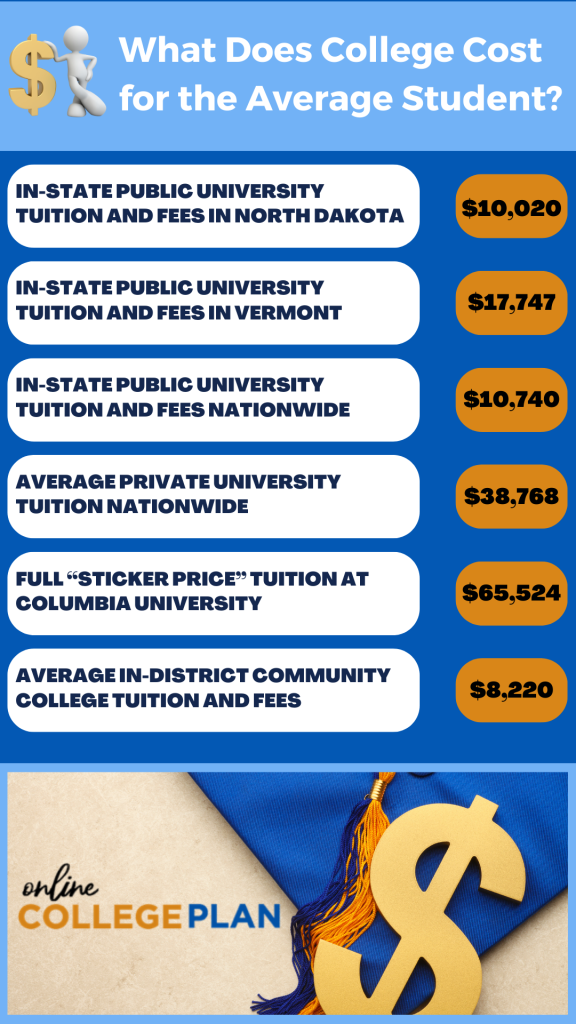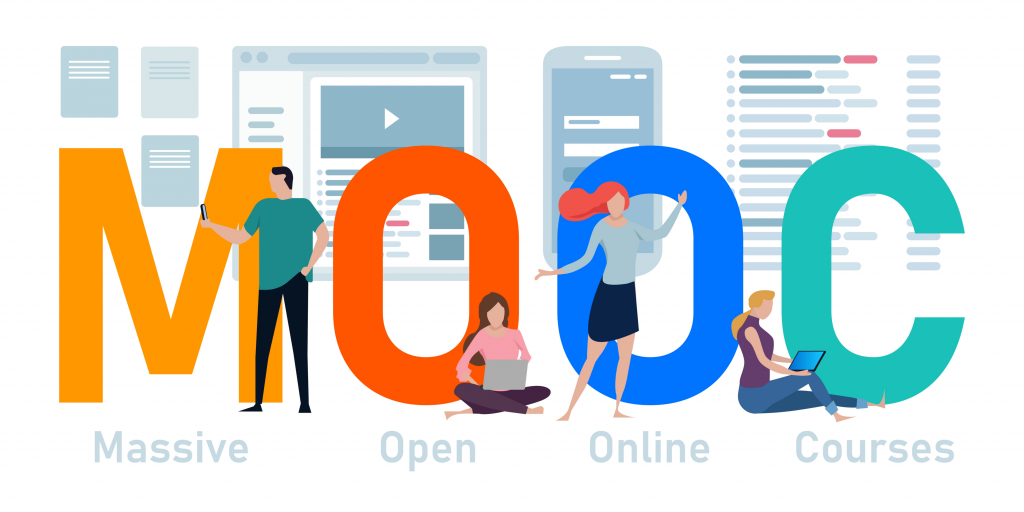Tuition-Free Online Colleges and Free Online Degree Programs

Find your degree

The big question: Can college REALLY be tuition-free? First let’s ask: Is college necessary? You can make it without it, sure. But, for a vast majority of Americans, getting to attend college is still synonymous with greater lifetime earnings, an opportunity for jobs, and a more enriching life.
Our “tuition-free” article was originally published in June 2023 and updated in December 2023.
Simultaneously, no single type of spending has increased as quickly as higher education tuition costs except health care expenses over the last 40 years.
In fact, higher education costs have increased eight times as quickly as the average American earner’s wages since the early 1980s. Yes—you read that correctly—eight times! Student debt is no joke. Even middle-income students find it difficult.
Short of a full tuition scholarship, the situation might seem bleak. But while college may seem like a totally unrealistic investment, the facts stand that higher education is still worth it in the vast majority of cases (even with the cost increase).
Of course, here at Online College Plan, we don’t believe that any future student should jump into a degree program without proper research. With our years of experience in researching higher education topics, we’ve learned a thing or two about how free online college works and how to save money on your college education.
The cheapest online college may not be the best option, even if you need to save money. So be sure to research plenty of tuition-free online colleges before making an online school choice. Here’s a secret—students might not need those full tuition scholarships after all.

In this guide, we’ll show you some ways in which you can avoid the student debt that hits so many college students. We’ll also discuss ways to minimize future debt by identifying some of the most affordable online colleges and free online college courses. Free college tuition for you might not be out of reach. You may even be able to graduate debt-free!
In this guide on free online degree programs, we’ll walk through the following sections:
- How Much Does College Really Cost?
- What Types of Free College Degree Programs Are There?
- Colleges Offering Free Online Courses
- The Best Online Schools Offering Free Tuition
How Much Does College Really Cost?

While tuition costs are likely the single largest expense many students pay throughout their college years, it’s not the only cost associated with going to school by a long shot. The cost of books and educational materials, moving wherever your school is located (if not online), living expenses, and fees can all add up. If you’re attending full-time and not working while in school, you’ll need to factor in the loss of current or potential income as well.
While undergraduate students of regionally accredited online colleges can often take out student loans for up to the full cost of living plus attendance, you may want to take a look at whether you want to spend that amount on a given higher education program first. Looking at tuition-free online colleges might be a better option.
In fact, much like America’s rising healthcare expenses, college pricing has one of the widest ranges of any other product type. What one pays on college can range from $0 to well over $50,000 a year depending on the type of school one attends, the financial aid one successfully applies for, future arrangements such as studying and working in public service roles, and the location one chooses to go to school in. Just looking at averages, the following is how much college “costs” for an average student attending any of the following:
That’s quite a range! And while few students do end up paying the entire “sticker price” of an institution, it’s worth noting that a year at an average in-district community college program is around 1/12th of paying the full price at an Ivy League institution. It is well worth it to look into community college whenever you can.
What this shows us is that there are a variety of ways to lower the cost of college education. One of the main ways in which you can do so is by choosing an affordable or even free community college, four-year college, or university. While tuition-free online colleges are somewhat scarce, they do exist.
Interested in affordable and high return-on-investment online colleges? Be sure to check out the 50 Most Affordable Online Bachelor’s Degree Programs in America. And for those interested in a graduate program, have a look at our list of the Cheapest Online Master’s Programs.
What Types of Free College Degree Programs Are There?

Strictly speaking, a vast majority of tuition-free online colleges aren’t “free” even if they offer tuition-free online access to classes. The cost of living while you are studying, supplies, and so forth make even the “freest” college education cost something.
With that said, there are several ways to get a free bachelor’s degree online or at least find some free or cheap online college courses. You may even be able to reduce the cost of your education to close to nothing. This is an amazing financial “win,” given the current cost of higher education. You might be surprised to find out the number of colleges with a no-tuition promise.

So what are the main ways you can reduce the cost of college close to $0?
- Pursue free online classes and “test out” these online classes in a paid program later on.
- Gain admission to a college or university that meets 100% of demonstrated financial need.
- Attend an in-state or in-district community college which is 100% free.
Let’s take a closer look at these three categories of free college education.
1. Test Out of Classes or Get Credit for Real-life Experience
First, a wide range of online free online colleges offer students who feel they have enough experience or knowledge of a subject matter to “test out” of courses. Some online colleges that offer this service, particularly tuition-free online colleges, are known as competency-based colleges. Additionally, some of these colleges also accept work experience for credit.
Many of these online colleges are geared towards adults who are working full-time and need the greatest amount of flexibility possible to achieve their educational goals. If you think you may want to attend a competency-based degree program, you can lower your eventual cost of education and the time it takes you to get your education by starting to learn course materials before you are enrolled. It’s like getting free tuition and a free degree online. Another way to do this cheaply is to attend community college.
Some of the best online universities offer free accredited online college courses known as MOOCs (massive open online courses). and there are many additional free tuition programs or free online college courses from other sources as well. By learning in this way — or on the job — you could be setting yourself up to “test out” of courses within a competency-based degree program.
While most programs of this type won’t let you test out of the entirety of your degree program, you can greatly reduce the time and money it costs to attend the program, oftentimes by up to one-half or two-thirds of a program length.
2. Look for Schools With Endowments That Allow the School To Meet 100% Of Demonstrated Need
Second, a range of the best online colleges and community college programs in the nation have high enough endowment (funding) levels to be able to meet 100% of the demonstrated financial need of all admitted students. In other words, even an Ivy League institution can be a tuition-free college.
Many of these online colleges are among the best in the nation and will have correspondingly harder admission standards. So this option may not work for you unless you are an exemplary student. But the way this option works is that you gain admission to a college or university that meets 100% of need.
And then you or a family member fill out your Federal Aid application (FAFSA), showing that your expected family contribution is effectively $0. Many of the best schools in the nation have even raised the maximum earnings you or your family can have and qualify. For some of the top schools in the nation, if you or your family makes less than $65,000, you get free tuition.
3. Look For Local Schools and Community Colleges Offering Free Tuition to Resident Students and Employees
Our third option for obtaining a free college degree is the most widespread and easily available. A range of states and metropolitan community colleges and university districts have instituted free tuition for students who are within the coverage area of the school or community college. Many of these free online colleges include additional stipends for the cost of living as well as all required educational materials, such as textbooks.
These free tuition programs are primarily offered to undergraduate students who have graduated from high school within the district or state of the community college. Students attend these programs and get free college tuition. Additionally, these free college tuition programs may be available to individuals who have worked within the district of the community college and would like to return to complete a degree. Occasionally, you will see free or discounted graduate degree programs, too. It’s a way of giving back to the community, so students pay nothing and get a free online college education.
While your eventual goal may be a bachelor’s degree or beyond, associates are some of the best “bangs for their buck” degrees out there (particularly when free). Additionally, many community college programs provide “transfer agreements” with four-year colleges and universities. These undergraduate transfer student agreements allow interested students to gain automatic admission to local public universities if they meet certain requirements (such as keeping their GPA above a certain level).
So, it is well worth your time (and money) to look into community college. If you want a free online bachelor’s degree or want to graduate debt-free, it’s a great option.
The Best Colleges Offering Free Online Courses

The emergence of massive open online courses (MOOCs) has opened the door to being able to obtain a world-class education for free. Many of the world’s top universities offer a wide range of courses that are presented fully online and for free (or a nominal fee for a certificate). Earning the equivalent of a free online college degree has never been easier.
While it’s unlikely that MOOCs will lead directly to a degree — except through a few experimental programs — MOOCs can be used as the first option for obtaining a free college education, as we describe in the last section. Namely, you can use an education gained through tuition-free college classes to then “test out” of courses at a competency-based college or university.
This can — at the very least — drastically lower the time and cost of obtaining a degree. Community college is also a fantastic idea. Alternatively, if you’re primarily seeking job skills or knowledge instead of college credits, any of these locations are great options for obtaining a free online education. You’d be surprised at the number of free college online courses available to anyone who wants to learn.
MIT OpenCourseWare
The Massachusetts Institute of Technology is one of the world’s preeminent universities in social sciences, technology, business, and more. In fact, many people have remarked that you could get an entire free business degree online at no cost from MIT! This forward-looking university has taken a number of steps toward making world-class education more easily available to all and is also one of a handful of universities in the United States to meet 100% of demonstrated financial needs.
This means that beyond free open online courses (MOOCs), students who make less than a certain amount (or whose family does) can attend MIT for free online. Potentially the hardest part of that process is gaining admission, as MIT has one of the most competitive admissions processes of any school on the planet.
In an effort toward making higher education available to the widest possible audience, MIT was an early proponent of MOOCs and helped to establish the largest collection of free college tuition courses of any university. MIT calls its free online college degree platform OpenCourseWare, and on it, you can find tuition-free college classes at the bachelor’s degree and graduate levels (a rarity among other entities on this list) on thousands of topics. Essentially, this means you could attend MIT tuition-free.
One unique element about MIT’s OpenCourseWare is that the bar to placing a course onto the platform is actually somewhat low. Not all courses offered on the platform are fully “finished,” with some including videos of all classes, some including just reading lists and notes, and others including a whole online course-like experience. While this may be a downside for some, it has allowed MIT to provide a much wider range of free online “courses” to the public than any other competing institution.
You may also want to check out MIT’s financial aid programs.
Stanford University
Stanford University has become a household name as potentially the best University in the Western United States. The school is a leading figure in the technological innovations that have occurred in Silicon Valley. The school has a student body of over 17,000. With the growth of online education, one wouldn’t expect Stanford to be far from the pulse, and they aren’t. Particularly known for their offerings in computer science, psychology, and a range of other topics, Stanford’s fully open online courses (MOOCs) don’t disappoint.
Located on the Coursera, and EdX platforms, Stanford’s online offerings are more defined into individual tracks than those of MIT. Though MIT offers a much wider range of courses, instructors at Stanford have focused on providing support for communities to learn along clearly defined paths.
A range of the most popular MOOCs of all time have been created by Stanford, often covering topics related to in-demand work skills, including machine vision, data science, blockchain, algorithms, game theory, and more. A full list of free online Stanford courses provided as MOOCs on all platforms may be found here.
You may also want to check out Stanford’s financial aid programs.
The University of Michigan

The University of Michigan offers the third-largest concentration of MOOCs (Massive Open Online Course) from an American university. Known for its world-class programs in a wide range of disciplines, including psychology, nursing, social sciences, library sciences, social work, and more, Michigan is able to offer a different focus on MOOCs than other top universities. Alongside a greater variety of courses not in computing, the University of Michigan is a great place to take free tuition programs due to the quality control and standardization they employ in their MOOC offerings.
All free online MOOCs offered by the University of Michigan are fully verified by EdX, meaning they are of commensurate quality with full university course material. Additionally, the University of Michigan has built on these open availability courses to begin offering a number of unique programs constructed of MOOC-like courses. While paid, courses of study such as “micro Masters” can offer a much more affordable way to get a graduate degree-like experience.
Users of the EdX platform should note that while there is a paid “verified certificate” version of most (if not all courses) on the platform, that payment may be circumvented just by searching for individual free online courses outside of their pathway. This is generally true for all free tuition online schools on the EdX platform.
Also, don’t forget to check out the University of Michigan’s financial aid programs.
The University of Pennsylvania
The University of Pennsylvania is routinely ranked as one of the 10 best universities in the world. Known for innovative programming and wide-ranging research initiatives, Penn’s Online Learning Initiative is one of the prominent leaders within the MOOC creation space.
With courses housed on a variety of platforms, Penn’s Online Learning Initiative offers over 120 MOOCs as well as a host of bachelor’s degree online free programs that can be taken for credit, not-for-credit, as well as in non-degree programs. It’s also worth it to check out the school’s financial aid programs.
Some of the most unique aspects of Penn’s Online Learning Initiative offerings include the focus on Spanish-language content, with particularly strong showings in marketing and psychology. You can even study for a business degree online for free.
It’s of additional note that the Online Learning Initiative helps to bolster the already strong support measures offered by Coursera and EdX with their own world-class online pedagogy and film editing services. In fact, you can access free schooling online through the University of Pennsylvania via several platforms.
Students interested in business, game theory, and psychology all stand to benefit greatly by utilizing the University of Pennsylvania’s free online programs. A wide range of these courses is offered by the world-renowned Wharton School of Business.
The University of Illinois

The University of Illinois, based in Urbana-Champaign, is one of the finest information sciences, engineering, and business schools in the nation. The school is large, with a student body of over 50,000. In recent years they’ve built up a robust online presence of both free (massive open online courses, or MOOCs) as well as paid online for-credit programming. Particularly noteworthy clusters of online programming include a range of MOOCs, paid bachelor through doctoral degree programs, and professional certificate programs.
If you’re looking for MOOCs and free college degree programs from the University of Illinois, all are hosted on Coursera. A wide range of subjects is available, including education, computing, international development, health care, law, and even 3D printing. A range of innovative for-credit programs may be undertaken for a smaller fee than traditional coursework and provide the opportunity for individuals taking MOOCs to pursue a master of business administration or a master of accountancy degree.
The University of Illinois also has some excellent financial aid programs and an on-campus work program. And don’t forget to check out federal and state grants.
As an education consultant, I have seen firsthand how online education has revolutionized the higher education landscape by providing affordable and accessible options for students. Tuition-free online colleges and free online degree programs offer a flexible learning environment that allows individuals to pursue their educational goals without the burden of excessive student debt.
In order for a student to succeed in a tuition-free online program, they must have the self-motivation and discipline to complete coursework on their schedule. This is a potential limitation for some students who may thrive in a more structured learning environment.
Always remember that the key to success in any educational program, whether online or traditional, is commitment and dedication. For students who are able to balance their studies with other responsibilities, tuition-free online programs can offer a valuable and affordable option for obtaining a degree.
Eric Eng, Founder & CEO AdmissionSight
What Are MOOCs? More Details About Massive Open Online Courses
The first MOOCs were introduced by the Massachusetts Institute of Technology and were called OpenCourseWare. The project became known as MIT OCW. The tuition-free education program published all the school’s curriculum online and made it available to anyone for free. Thus the public could have online access to the same undergraduate and graduate course materials as any MIT student. MIT OCW has over 2000 courses!
Why Are They Called MOOCs?
MOOC is an acronym for Massive Open Online Courses. These free online college classes are massive because there is no limit to how many students can participate. So thousands of people can join at a time.
Open means that anyone anywhere can participate, not just college students. In most cases, there are no prerequisites to enroll. Online school is self-explanatory. The courses are all accessed through the Internet. And course indicates that these describe free college degree courses.
What Is the Purpose of a MOOC?
Massive Open Online Courses offer anyone the opportunity to learn. MOOCs offer free tuition for specific courses for those who cannot afford a full-time degree program. Some people take them to advance or change their careers. Others want to learn some new skills. Finally, many people take MOOCs for personal enrichment or the simple love of learning.
There is no doubt that MOOCs have altered the way we all learn. And because they are available globally, they bring people together. With MOOCs, students of all ages, races, nationalities, and backgrounds come to interact with others who share their interests. And this only enhances the online learning experience. Plus, the free tuition is a big draw.
While MIT was the first and most well-known provider of MOOCs, many other platforms emerged. Some are still here today, including:
- Khan Academy
- Udemy
- Alison
- Coursera
- edX
- FutureLearn
- Udacity
- Skillshare
- LinkedIn Learning
- Pluralsight
- Microsoft Learn
- Data Camp
- AWS Skill Builder
- Kadenze
- freeCodeCamp
- Codecademy
- Blackboard Open Education
- Hubspot Academy
- World Science U
- OpenClassrooms
- The Odin Project
Many MOOCs hosted on these platforms are created by Universities like Harvard, Stanford, and other prominent schools. These free online colleges are an excellent way to try out a topic or see if something interests you. Others are created by large organizations like Google, Linux, and Microsoft. These, too, are a great way to acquire in-demand skills.
Do MOOCs Offer Free Tuition?
That depends. Some MOOCs have free components of the courses offered, so you would get free tuition. Some of them offer different financial aid programs. Others require payment. But almost all of them provide a couple of different options:
Free Auditing Mode
In audit mode, students have access to the readings, lectures, assignments, and homework. But they cannot take graded quizzes or exams. Usually, they will not earn a certificate of completion. Still, for those who are only taking classes to learn life skills or personal enrichment, the paid components won’t matter much. Unless you’re looking for a free bachelor’s degree online, auditing these high-quality programs will satisfy your thirst for knowledge.
Paid Enrollment Mode
With paid courses, students can do everything from audit mode. But they may also have one-on-one interactions with an instructor. In addition, they can take part in graded quizzes and exams and participate in keystone projects. And, of course, they earn a certificate of completion.
In paid mode, MOOCs usually consist of:
- Lessons
- Discussion topics
- Reading lists
- Study notes
- Lectures
- Homework assignments
- Quizzes
- Exams
- Textbooks
- Interactive learning activities
Can You Get Financial Aid For MOOCs?
Many MMOC platforms offer financial aid for college students who cannot afford the paid versions. To qualify, you will want to visit the platform’s financial aid pages.
Students can request free tuition, a scholarship, or financial aid on most sites. For example, on edX, you can fill out an application and confirm your income. You’ll also need to submit a 200-300 word answer to some essay questions.
Other MOOCs have similar free tuition and financial aid policies. So while you may not get completely free tuition, you might get financial aid or a discount of some type.
Other ways to pay:
If you don’t qualify for financial aid or free tuition, there may be other avenues. For example, talk to your boss or supervisor if you are taking a MOOC to learn new work skills. Employers appreciate workers who show initiative. They just might pitch in to help you get that certificate of achievement.
Can I Get Credit for Completing a MOOC?
Sometimes. Usually, if you pass the MOOC, you can earn a completion certificate, badge, or some other reward. Unfortunately, with free tuition MOOCs, you usually have to pay a small fee to access a certificate of completion. Although there are a few where you can earn the certificate with no fee.
Some free online colleges let students earn academic credit for completing a MOOC. But you generally need to be enrolled at the school. Credit for Certain MOOCs might be available if you took the tuition-free college course through a specific institution. And in rare cases, your MOOC may count as life experience credits. However, you will want to check with your school before assuming you will earn academic credit for any online course.
In some ways, MOOCs are similar to adult education programs at a community college. But instead of meeting at the community college, students attend online.
The Best Online Schools Offering Free Tuition

Typically speaking, the “better” the school you attend, the larger its endowment. School endowments are raised by alumni who do well and love their alma mater. They are also raised by colleges and universities that perform well at a specific activity or academic topic. Schools that are great at sports or that have excellent academic programming typically have larger endowments.
So what does this have to do with tuition costs? Well, many of the free online colleges with the largest endowments have made commitments to use some portion of that money to offset undue tuition costs of education for their students. A large chunk of those funds is funneled into financial aid programs.
Would you like to earn a tuition-free online accounting degree? How about a free online business degree? It’s not impossible if you know where to look. Free tuition programs do exist.
There are typically three groups of schools that are true tuition-free online colleges:
- Tuition-free colleges online that will meet 100% of demonstrated financial need without student loans
- Tuition-free colleges online that will meet 100% of demonstrated financial need with student loans
- Tuition-free colleges online that will meet 100% of the cost of tuition, room, and board, and so forth for all students due to a special mission (like military colleges) or due to being work colleges
You may notice that two of these categories — which are the most common arrangements — rely on applicants demonstrating financial need. So how does this work?
All regionally accredited colleges and universities provide the option for students to fill out a Federal Application for Student Aid (known as a FAFSA). This financial aid application takes a look at your (or your family’s) earnings in relation to the cost of the school you’re attending.
For most schools, the FAFSA is used to make you eligible for federally subsidized student loans. But for some schools with the strongest financial aid departments, your (or your family’s) expected contribution is used as a number over which you don’t have to spend a dime. These are called 100% need-met organizations. These tuition-free online colleges will meet your demonstrated need without the use of any student loans. These schools are essentially free for those who are below a certain income level.
Looking into financial aid programs for any school you would like to attend is a wise idea. You may be surprised to find that you could indeed be eligible for scholarships, assistance, or financial aid. With this assistance, you may not need to look for tuition-free online colleges after all.
A list of tuition-free online colleges that are 100% need-met reads like a list of the top colleges in the United States. All of the universities and tuition-free online colleges below meet 100% of your demonstrated need. Some utilize student loans, and some cover all expenses through grants and scholarships:
- Amherst College
- Bowdoin College
- Brown University
- Colby College
- Columbia University
- Davidson College
- Harvard University
- Northwestern University
- Pomona College
- Princeton University
- Stanford University
- Swarthmore College
- University of Chicago
- University of Pennsylvania
- US Air Force Academy
- US Military Academy (West Point)
- US Naval Academy
- Vanderbilt University
- Washington and Lee University
- Yale University
Additionally, a list of “work colleges” often allows students to free online degrees in exchange for working for the college or university throughout their college career. Members of the Work College Consortium may be seen below:
- Alice Lloyd College
- Berea College
- Bethany Global University
- Blackburn College
- College of the Ozarks
- Paul Quinn College
- Sterling College
- Warren Wilson College
Among the above 100% need-met colleges and universities, a small portion will allow you to get a free online degree. These are the schools we’ve pulled out as this year’s ranking of the best free online colleges and universities!
Brown University
Brown University is an Ivy League university located in the quaint city of Providence, Rhode Island. Brown is known for its innovation and completely “out of the box” thinking. Undergraduate students have the opportunity to design their own curriculum.
The Open Curriculum model at Brown is different from a typical college curriculum as students do not need to follow a set of courses in order to complete their education. Rather, they design a course based on their passions and follow that. This type of freedom and innovation is certainly extended to their graduate programming and their innovative online practices.
Brown offers four distinct online course options to meet the needs of professionals, undergraduates, pre-college hopefuls, and literally anyone interested in taking an online course via BrownX.
- Executive Programs
- Online Undergraduate Courses
- Online Pre-College Courses
- Online Open Courses
Social justice and equality are part of Brown’s mission statement. The university works to ensure that individuals are not penalized due to income. In the spirit of fairness and opportunity, Brown offers need-blind tuition for international students, low-income students, DACA, undocumented students, and more. If you have a demonstrated financial need, Brown is 100% committed to meeting that need by providing free online education.
Be sure to check out all of Brown’s financial aid options.
Columbia University
Columbia University is a research Ivy League university located in New York City. The link between Columbia’s research and its location is important as Columbia seeks to design education that reflects the endless resources one should expect to find in a city like New York. Like most mega metropolises, New York has a global focus. So, therefore, does Columbia.
Their online programs are completely in line with their on-campus mission. Columbia offers a number of online master’s degree programs through its various graduate and professional schools. Students may pursue a variety of professional certifications as well. The courses are offered online or as a hybrid. Take a look at schools offering online courses:
- School of Engineering and Applied Science
- School of Social Work
- School of Professional Studies
- Graduate School of Arts and Sciences
- Columbia Business School
- Earth Institute
- Columbia Medical Center
- Columbia Law School
Whatever your financial circumstances, Columbia University aims to bridge the gap with its generous need-blind policies. That makes it one of the top free online colleges on our list. The university assists individuals with a “full need” for U.S. citizens and eligible non-citizens.
Additional funding opportunities are also available. The 0 parents’ contribution policy ensures that parents who make less than $60,000 annually do not have to make financial contributions to the cost of attendance. The free college degree programs at Columbia are worth a closer look.
Be sure to look at all of Columbia’s financial aid options when considering this school.
Harvard University

Harvard University is arguably the most famous university in the United States. This Ivy League powerhouse has done an incredible job in recent years creating free MOOCS for anyone interested in expanding their mind.
This Ivy League university located in Cambridge, Massachusetts, has the highest level of research activity according to Carnegie, and maintains an extremely low student-to-faculty ratio of 7:1. The university houses some of the most famous professional schools in the world, including the world-famous Harvard Business School and Harvard Law School.
The Harvard Extension School is a terrific opportunity. You can earn undergraduate and graduate degrees as well as certifications or take courses. Are you looking to advance your career online? Try the extension school. Are you considering a shift in your career but looking to explore? Try one of the courses offered through the extension school. You’ll have the option to complete the certification or simply audit the course. Offerings include:
- Degrees
- Certificates
- Courses
- Pre-Med Studies
- Professional Development
- Learning In Retirement
Harvard offers need-blind opportunities for individuals with demonstrated financial need. Harvard wants to best to come to their university. To ensure they recruit the best, Harvard remains need-blind. The college guarantees that the need will “never affect your chance of being admitted to Harvard.”
In fact, many students are surprised to learn that Harvard does offer full-tuition scholarships. The average full tuition scholarship awarded to incoming students in 2019 was over $62,000. And over half of first-year students were eligible for full tuition scholarships or financial aid. Maybe you have the grades to get into this prestigious university, but you can’t afford it. Don’t give up your dreams before looking at all your options.
Northwestern University
Northwestern University is a private four-year institution located in Evanston, Illinois. The student-to-faculty ratio is 6:1. This research university is an R:1 institution with the highest research activity, according to Carnegie. The university offers innovative opportunities to expand your horizons both personally and intellectually.
The university continues to expand its academic programs through its innovative online degrees. The School of Professional Studies offers online degrees and certifications to students seeking advanced degrees or simply looking to further their education. Courses are offered in a wide variety of formats, including fully online and in a blended model. Here are just a few areas of study available online via Northwestern Online:
- School of Professional Studies
- School of Education and Social Policy
- Feinberg School of Medicine
- The Graduate School
- The Pritzker School of Law
- The McCormick School of Engineering
Northwestern does have a need-blind policy for students who are U.S. Citizens and other permanent residents. The university ensures that your financial background will not affect its decision to admit you. It’s worth looking into Northwestern’s online degrees if you have a particular area of interest.
Stanford University
Stanford University is known for its innovation and is responsible for the incredible technological boom of the surrounding area. This university is home to some of the greatest professional schools in the world and offers incredible degree opportunities in the fields of robotics, environmental science, humanities, biology, psychology, and so much more. People with a wide variety of interests fit in well at Stanford.
Their interdisciplinary research model means that research at Stanford doesn’t happen in isolated silos but seeks input from a wide variety of disciplines. Stanford Online offers online graduate certifications and online degree programs. There is an impressive number of academic programs for individuals who are looking to advance their careers. Take a look at schools offering online programming.
- Graduate School of Business
- Stanford Continuing Studies
- Stanford School of Engineering
- Stanford School of Humanities and Sciences
- Stanford Law School
- Stanford School of Earth, Energy, and Environmental Sciences
- Stanford School of Medicine
- Stanford Graduate School of Education
When requesting financial aid, how can you be sure Stanford won’t admit based on financial need? The answer is that they have a need-blind policy. Most of the best institutions in the US use a need-blind policy to ensure that students are not discriminated against due to need. This keeps free college degree programs as fair as possible.
University of Pennsylvania

The University of Pennsylvania is a private Ivy League university located in Philadelphia. It currently enrolls over 25,000 college students and still maintains a student-to-faculty ratio of just 6:1. UPenn has an impact on local and global communities and includes a global think tank devoted to innovations locally and abroad.
Students are awarded the president’s innovation prize of $100,000 for students who create a “commercial venture that makes a positive difference in the world.” UPenn has honored such thinkers since its founding year in 1740. There are a number of online programs available through the Penn Online Learning Initiative, including degrees, certificates, MOOCs, CECs, and more. This online learning platform is second to none and has something for everyone.
- Degrees and Certificates
- Non-Credit Certificates
- Continuing Education Units
- MOOCs
- Series and Specializations
- Micro-credentials
UPenn is one of the top universities in the world and, as such, seeks to recruit only the best scholars from across the globe. Part of the way they achieve this goal is to offer need-blind tuition to any individual who can show a demonstrated financial need.
Vanderbilt University
Vanderbilt is a private institution located in Nashville, Tennessee. This doctoral university has very high research activity and enrolls over 12,000 while maintaining a student-to-faculty ratio of 7:1. The university offers online degree programs in engineering, education and development, music, medicine, nursing, law, business, and more. Vanderbilt currently ranks among the top universities in the world and continues to evolve locally and globally through its innovative online degree offerings.
There are three schools currently offering advanced degrees online. Vanderbilt has done an excellent job honing in on in-need areas that are in high demand. If you are looking to advance your career in one of the following fields, then you can’t go wrong with Vanderbilt Online.
- Business
- Education
- Engineering
Vanderbilt is need-blind in the admissions process seeking to offer 100% financial aid to students who have been admitted to study with Vanderbilt. This means that individuals who show a demonstrated financial need cannot be turned away for admission. Admission remains merit-based, therefore, and not need-based.
Free College Online: More About Financial Aid and Scholarships
If you feel discouraged looking for tuition-free colleges, don’t be. For many students, federal financial aid can cover a large portion of tuition costs and fees. But to qualify, you’ll need to apply. Applying for financial aid is simple, and you can do it online. You’ll need to fill out the FAFSA form, which stands for Free Application for Federal Student Aid.
Before you can fill out the FAFSA, you will register for an FSA ID. This identification will be used as your legal signature throughout the process of applying for assistance. With this ID, you can log in to update or check on the status of your application. The Department of Education can take between three to five days to process FAFSA forms. So the sooner you complete the paperwork, the sooner you can be on your way to a free college degree.
You won’t receive student loans or money from FAFSA. Instead, it is an online form used to determine your level of financial need. Once your information is assessed, you will receive a list of funding options you qualify for. A Student Aid Report (SAR) is also generated on the site. This document contains basic information about your eligibility for assistance. This could consist of both federal and nonfederal financial aid.
You may be eligible for many types of free college tuition and financial assistance through the FAFSA form. Some of these may include:
- Scholarships
- Government student grants
- Government student loans
- Government-sponsored work-study programs
- Grants
What Does EFC Mean?
You may frequently see the term EFC while applying for assistance. EFC stands for “Expected Family Contribution.” This is a number that school financial aid departments use. This number determines how much money you would get if you enrolled in one of the school’s programs. The EFC is calculated the same way for everyone.
And there is a specific legal formula used. It takes into account the taxable and untaxed income and assets your family has. Plus, it calculates benefits like social security and unemployment. Additionally, the size of your family is a consideration. This is especially true if more than one family member is attending college simultaneously.
What Does COA Mean?
Another term you will often see when researching free college degree options is COA. COA stands for “Cost of Attendance.” Essentially, this is how much it will cost you to go to either an on-campus or online school. Most schools calculate the DOA as the total cost for one school year. The COA does not just look at a school’s tuition costs. There are other costs factored into your COA as well. These may include:
- Miscellaneous fees
- Student housing
- Room and board (If you are not staying in student housing)
- Books and supplies
- Transportation
- Loan fees
- Personal computer
- Child or dependent care
- Study-abroad costs
Scholarships for a Free College Degree
Scholarships are financial contributions that help students pay for college. Millions of scholarship dollars are given away each year, and there is plenty of this “free education” money to go around. But you need to know how to find the best scholarships. Scholarships might be one-time gifts or renewable for multiple years. And you are not limited to only one type of scholarship either. You may be eligible for many.
Full-Tuition and Full Ride Scholarships
What Is a Full-Tuition Scholarship?
As the name suggests, a full-tuition scholarship pays for a student’s tuition to attend college. The student is still responsible for other expenses like books, housing, etc. but they get free tuition. Full tuition scholarships are not uncommon, but they take some effort to win. Essentially, you’re getting a free education with these scholarships. We’ll discuss that more momentarily.
What Is a Full-Ride Scholarship?
A full ride-scholarship is like any other scholarship that awards free tuition money for your college education. But there’s one significant difference—full-ride scholarships cover the entire cost of your college education. And that doesn’t just include your online school tuition. In many cases, full-ride scholarships offer free tuition for your education plus:
- Room and Board
- Books
- Supplies
- Lab Fees
- Meals
A full-ride scholarship will occasionally even cover basic living expenses beyond this list. Now that’s a completely free education!
Needless to say, if you get a full-ride scholarship, it’s almost as good as winning the lottery. The financial award for these scholarships can be anywhere from $25,000 to $55,000 or more. Pretty swell, huh?
What Kinds of Full-ride Scholarships Are Available?
Full-ride scholarships are awarded based on many different factors. For example, private organizations, schools, or the government may offer full-ride scholarship programs. Students can earn these free tuition and full-ride scholarships via athletic or academic achievement, leadership, and more.
Athletic Full Ride Scholarship Programs
These are the most well-known full-ride scholarships. Students who show particularly strong athletic ability may receive an athletic full-ride scholarship. These are generally for Division I or II schools. They are typically offered to students in basketball, football, tennis, volleyball, and gymnastics.
Government Full Ride Scholarship Programs
A government full-ride scholarship is typically related to the military in some fashion. Examples of this include students at a military academy or those in the ROTC program.
Financial Need-Based Full Ride Scholarship Programs
We’ve touched on this earlier. Some schools offer full-ride scholarships to low-income students who would otherwise not be able to pay for their education. Individuals and private organizations may also provide full-ride scholarship awards based on financial need.
State-Sponsored Full Ride Scholarship Programs
Different states sometimes offer full-ride scholarships. Often, these scholarships are to be used at a specific community college or university. They may be awarded to students studying a particular trade or area of interest.
Merit-Based Full Ride Scholarship Programs
This type of full-ride scholarship is also fairly common. Merit-based scholarships are awarded to students based on academic performance. Often, they are determined based on testing or a student’s GPA.
Other Options for Full Ride Scholarship Programs
Of course, the full-ride scholarships listed above are not the only ones out there. Sometimes, students are awarded based on heritage, location, area of interest, and other factors.
Is It Hard to Get a Full-Ride Scholarship?
Naturally, not all students will qualify for a full-ride scholarship. This is because they are highly competitive, and earning them takes a lot of effort, a little luck, or both. However, a few things might increase your chances of winning an all-expense paid education.
First, start early. If you are pursuing a competitive scholarship, start taking proactive steps as soon as possible. This means you’ll want to begin applying for scholarships while you’re still in high school (or even junior high). The earlier you start, the better chances you will have.
Focus on the specific area you’re good at. For academic, merit, or athletic-based scholarships, you need to become the best you can be. If it’s an academic scholarship you want, stay at the top of your class. Be disciplined, study hard, get good grades, and take AP or honors classes. And strive for the highest possible scores on the ACT and SATs.
If it’s an athletic scholarship you want, focus on developing your skills in the sport you love. If you’re very talented, you might even be offered more than one scholarship and have your choice of school. Of course, these same athletes need to show good academic skills too. Maintaining the right balance between sports and school is critical.
If you’re pursuing a merit-based scholarship, you’ll want to focus on the qualifications necessary to earn it. This could be time spent in leadership, community service, or internships. Be sure to get all the details and follow the instructions precisely to qualify.








